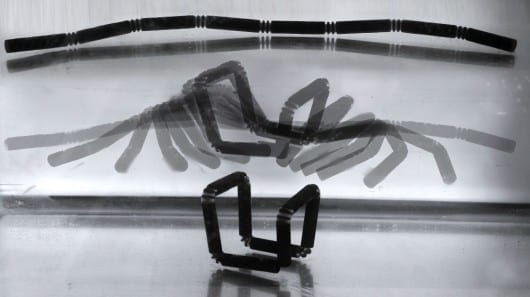
Reduced pain in 67 percent of patients who received the treatment
Patients with cancer that has spread to their bones are often treated with radiation therapy to reduce pain. But if that treatment doesn’t work, or can’t be used again, a second, effective option now exists. Results of a clinical trial on the new therapy, presented by a researcher at Jefferson’s Kimmel Cancer Center, is being presented at the annual meeting of the American Society of Clinical Oncology (ASCO).
Mark Hurwitz, MD, Director of Thermal Oncology for the Department of Radiation Oncology at Thomas Jefferson University and Hospital reported that the treatment, magnetic resonance image-guided focused ultrasound (MRIgFU) ablation therapy, significantly reduced pain in 67 percent of patients who received the treatment. The device, known as ExAblate, uses numerous small ultrasound beams designed to converge on a tumor within bone, heat it and destroy it.
“Pain is a common, often debilitating symptom of the spread of cancer to bones. We are pleased to now have a second therapy that can improve a patient’s enjoyment of life,” says Dr. Hurwitz, who led the clinical trial. A number of cancers spread to bones, and a substantial proportion of patients live for years with these metastases, which can have a profound impact on a patient’s quality of life, he adds.
The findings of the trial led to approval of ExAblate last October by the U.S. Food and Drug Administration as second-line therapy for palliation of painful metastatic bone tumors. The first-line therapy is typically radiotherapy.
“The response to ExAblate was as good as radiotherapy, which was notable because it is very unusual to see a second-line treatment with a response rate that is as high as first-line therapy,” Dr. Hurwitz says.
He added that use of ExAblate offers several advantages compared to other ablative therapies. “It is non-invasive and provides more detailed anatomic information so that we can visualize the complete beam path to make sure that critical structures such as vessels and nerves are not in the way,” Dr. Hurwitz says. “We are also able to monitor the temperature in the tumor as well as in nearby normal tissues so that we do not inadvertently heat normal organs and tissues.”
ExAblate has also been approved for treatment of uterine fibroids.
The Latest Bing News on:
MRIgFU
- Feed has no items.
The Latest Google Headlines on:
MRIgFU
[google_news title=”” keyword=”MRIgFU” num_posts=”10″ blurb_length=”0″ show_thumb=”left”]
The Latest Bing News on:
Cancer pain
- Colon cancer cases have more than doubled in young people since 1999, new research showson May 8, 2024 at 9:01 pm
Late 20s to early 30s: The rate of people diagnosed with colon cancer in this age range increased about 70% from 1999 to 2020. Late 30s: For this age group, the rate increased 58% in the same time ...
- 'Everything Hinges on Kate Middleton's Well-Being' for Prince William as He Carries Family's Pain (Exclusive)on May 8, 2024 at 5:00 am
As Prince William balances family matters with an elevated leadership role in the monarchy due to King Charles and Kate Middleton's cancer diagnoses, but his priority remains on supporting his wife.
- Cancer Pain Guidelines evaluation stresses on safe opioid practice and patient feedback systems, claims studyon May 5, 2024 at 7:59 am
Cancer pain is the most distressing symptom in a patient's life, with fear of unrelieved pain sometimes exceeding the patient's fear of death.Recently published research paper evaluates the ...
- Daniel Do wants to develop better cancer pain management strategieson May 3, 2024 at 2:35 am
MassLive is highlighting Asian American and Pacific Islander leaders across the state. Daniel Do a student at Harvard Medical School.
- Tramadol in the Treatment of Neuropathic Cancer Painon May 1, 2024 at 5:00 pm
a difficult to control pain. Cancer-related neuropathic pain is a heterogeneous syndrome that cannot be explained by a single aetiology, mechanism or anatomical lesion. One of the strengths of the ...
- Update in Cancer Painon April 17, 2024 at 5:00 pm
The WHO in 1986 established a stepladder approach for the treatment of patients with cancer pain. Clearly, the WHO method has been of enormous benefit for the treatment of cancer pain worldwide.
- Virtual Reality Therapy Helps Decrease Cancer Pain, Study Findson April 10, 2024 at 5:00 pm
A new study has used virtual reality (VR) to help reduce cancer pain for hospitalized patients, potentially providing a non-invasive and non-pharmacologic approach to improve the quality of life for ...
- How Virtual Reality Might Ease Cancer Painon April 8, 2024 at 7:58 am
A short virtual reality session significantly lessened pain in patients with cancer, a new study has found. Most people with cancer experience pain and treatment usually involves pain-relieving ...
- Doctors Dismissed My Pelvic Pain for Years — Until I Was Diagnosed With Ovarian Canceron April 7, 2024 at 5:00 pm
Understand what causes ovarian cancer pain, what ovarian cancer pain feels like, and what you can do to help manage your pain. Hairdressers, beauticians, and accountants may have an increased risk ...
- Identical twin of teenager with rare form of cancer says she gets the same pain as her sister - but is completely healthyon April 5, 2024 at 8:21 am
Sophie Walker, 17, was diagnosed with Wilms tumour, a type of kidney cancer, in October 2017. Strangely, her twin sister, Megan, also suffered from similar symptoms - including back pain in the ...
The Latest Google Headlines on:
Cancer pain
[google_news title=”” keyword=”cancer pain” num_posts=”10″ blurb_length=”0″ show_thumb=”left”]










